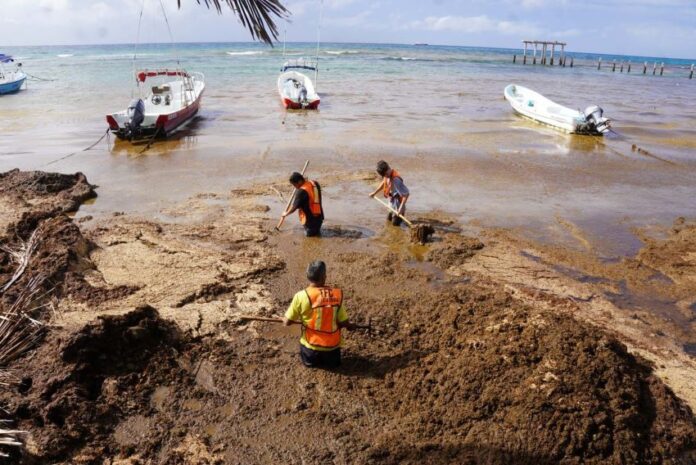Despite constant efforts by authorities to keep Mexico’s Caribbean beaches clear of sargassum, researchers are expecting record levels of that seaweed to wash up along the shores of Quintana Roo state. Authorities have been battling to keep beaches clear of seaweed to maintain tourism levels, as tourism is the main source of revenue for much of Quintana Roo state.
More than 522,226 metric tons of sargassum could wash up on Quintana Roo’s beaches this year, higher than the record 2018 level, as a large belt of hundreds or even thousands of kilometers long was observed via satellite, extending into the Atlantic, according to scientists.
In May, there were 37.5 million metric tons of sargassum floating in the Atlantic, which is nearly double that of July 2018, according to data from the University of South Florida. The atmospheric conditions were similar in both years.
This is unwelcome news for tourists and the Quintana Roo economy that depends on them. Though the brown seaweed is naturally beneficial to marine ecosystems in the open ocean, it can be harmful to marine life, plants, coral and human health when large quantities reach the coast. As it decomposes, it gives off a foul smell similar to rotten eggs.
Scientists expect the current sargassum belt to advance through the Atlantic between Brazil and Africa before moving north through the Caribbean Sea towards the southern coast of the United States. Brigitta van Tussenbroek, a seagrass researcher at the National Autonomous University of Mexico (UNAM), described the floating mass of seaweed as “larger than any country.”
Lorenzo Álvarez, a UNAM reef-systems researcher, expects the season’s peak to begin in the next two to three months. However, Álvarez stressed that there has been a lack of continuity when it comes to monitoring the phenomenon.
The clean-up effort
The popular beach destination of Playa del Carmen, about an hour from Cancún, is battling to keep its beaches clear of seaweed.
Playa del Carmen Minister of Environment and Climate Change Samantha Álvarez said that over 100 people are working with machinery on Playa del Carmen’s beaches to remove the sargassum, including municipal personnel, state brigades and 50 marina personnel.
Rodrigo de la Peña, the president of the Cancún, Puerto Morelos and Isla Mujeres Hotel Association, said that nearby Puerto Morelos has also been hit particularly hard.
“It’s tremendous,” De la Peña said, “We have barges working off the coast and (with) machines on some beaches but some of the hotels don’t allow machinery because they are located within natural parks, which forces us to do all the work by hand.”
Meanwhile, in the seaside town of Mahahual, fishermen reported that they have had to halt their activities due to the excess of sargassum.
With reports from La Jornada and Riviera Maya News
